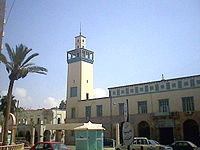Benghazi
Benghazi (Arabic بنغازي, transliterated Banġāzī) is a seaport in Libya, Africa. The present name is derived from that of a pious benefactor of the city named Ghazi or "Sidi Ghazi," as the locals called him, who died about 1450. The city was renamed "Bani Ghazi". The population was 500,120 in 1995 (census) and has increased to 660,147 in the 2004 census.
History

Modern Benghazi, on the Gulf of Sidra, lies a little southwest of the site of the ancient Greek city of Berenice or Berenicis. That city was traditionally founded in 446 BC, by a brother of the king of Cyrene, but got the name Berenice only when it was refounded in the 3rd century BCE under the patronage of Berenice (Berenike), the daughter of Magas, king of Cyrene, and wife of Ptolemy III Euergetes, the ruler of Egypt. The new city was later given the name Hesperides, in reference to the Hesperides, the guardians of the mythic western paradise. The name may have also referred to green oases in low-lying areas in the nearby coastal plain. Benghazi later became a Roman city and prospered for 600 years. The city superseded Cyrene and Barca as the chief center of Cyrenaica after the 3rd century CE and during the Persian attacks, but when the Arabs came, in 642-643, it had dwindled to an insignificant village among magnificent ruins.
In the 1200's, the small settlement became an important player in the trade growing up between Genoese moerchants and the tribes of the hinterland. In 16th century maps, the name of Marsa ibn Ghazi appears. Benghazi had a strategic port location, one that was too useful to be ignored by the Ottomans.

It was in 1578 that the Turks invaded Benghazi and it was ruled from Tripoli by the Karamanlis from 1711-1835, then it passed under direct Ottoman rule until 1911. Under the Ottomans, Levantines, Maltese, Greeks and Jews formed the trading community, Turks, Arabs and Berbers formed ruling castes, and Black Africans acted as labourers and domestics. The city was a port in the slave trade that supplied Islamic markets, until European consuls agitated for its suppression not long before World War I. Under later Ottoman rule Benghazi was the most impoverished of the Ottoman provinces. It had neither a paved road nor telegraph service, and the harbor was too silted to permit the access of shipping. Greek and Italian sponge fishermen worked its coastal waters. In 1858 and again in 1874 Benghazi was devastated by bubonic plague.
In 1911 Benghazi was freed from the Ottoman empire, and became part of Italy. Under Italian colonial occupation, particularly under Mussolini, Cyrenaica suffered ruthless repression of the Libyan resistance. In 1931 the Libyan patriot Omar al-Mucktar was hanged at Souluk, a village just west of Benghazi, effectively ending Libyan resistance. Heavily bombed in World War II, Benghazi was later rebuilt with the country's newly found oil wealth as a gleaming showplace of modern Libya.
Geography

Benghazi is one of the sub regions of the area referred to as Cyrenaica, the others being the Jabal Akdhar and the coastal plain running east of Apollonia. Cyrenaica is surrounded by desert on three sides, hence in ancient times the most accesible civilisation was to the North, across the Mediterranean, in Crete and Greece, only 400km away.
Benghazi is surrounded by the 'barr', arid steppe. The Jabak Akdhar, literally, 'the Green Mountain', just north of Benghazi, rises to the east. Here the vegetation and climate is more Mediterranean in feel with none of the desert landscapes found further south. A large section of the western Jabal Akdhar is taken up by the fertile Al Marj plain. Further east is the second level of the Jabal Akhdar, between 500m and over 875m above sea level, often thickly wooded and cut by ravines. Annual rainfall here, especially around Cyrene, can reach 500mm. It was this fertile site North-East of Benghazi that the Greeks chose for their settlement. The soil in Benghazi is a rich red colour and very clayey.
To the north, below the steep cliffs of the plateau, lies a narrow belt of Mediterranean farmland. Here olives and other mediterrenean fruits and vegetables are grown. To the south, the forest and farmland gives way to juniper bush maquis and pre-desert scrub with some winter grazing.
Culture

Benghazi is one of Libya's major cultural centres. It is the country's second city and prinicipal city of Eastern Libya. Benghazi is thus also a bustling port and commercial centre.
As with other parts of Libya there is great racial diversity in Benghazi. The people of eastern Libya, Benghazi included, have in the past always been proud to be mainly Arab. In recent times however there has been an influx of African immigrants into Benghazi. There are also many Egyptian immigrants in Benghazi due to the fact that Benghazi is very close to Egypt and Sudan and enjoys a stronger economy. Libya's Greek community is also concentrated in Benghazi largely due to distance. The Greek island of Crete is a short distance from Benghazi and many families in Benghazi today bear Creatian surnames. The predominant religion in Benghazi is Islam although there is a small Greek Orthodox church found in the centre of the city that serves Benghazi's Christian community. For Muslims there are many mosques in and around the medina including the Atiq and Osman mosques as well as others.
Education in Benghazi, as is throughout Libya, is compulsary and free. There are many public primary and secondary schools scattered throughout the city as well as some private schools and a European school. The largest university in Benghazi, Garyounis University, was founded in 1955. The country's largest library containing over 300,000 volumes is also affiliated to the University. Benghazi is also home to the country's first university Al-Jami'a al-Libiya.
University
The University of Benghazi, named Garyounis after the Palestinian refugee, was founded in 1955.
